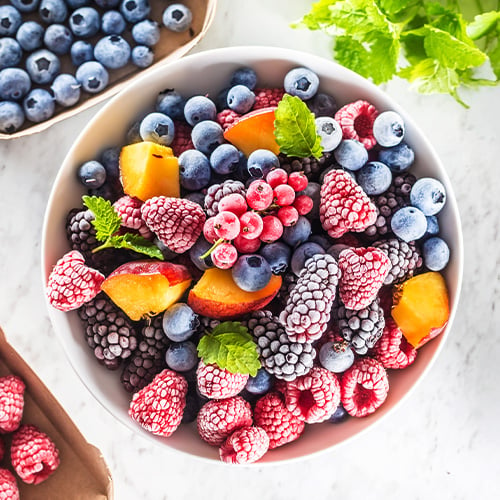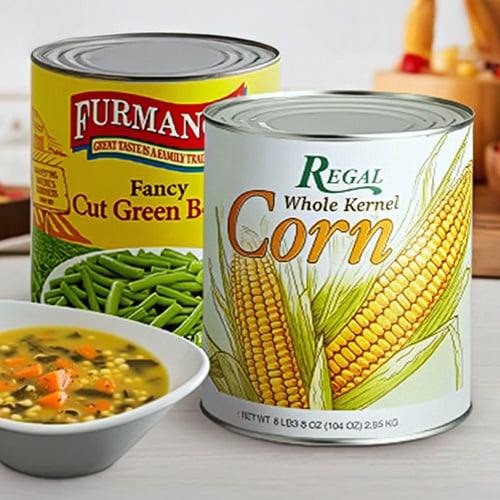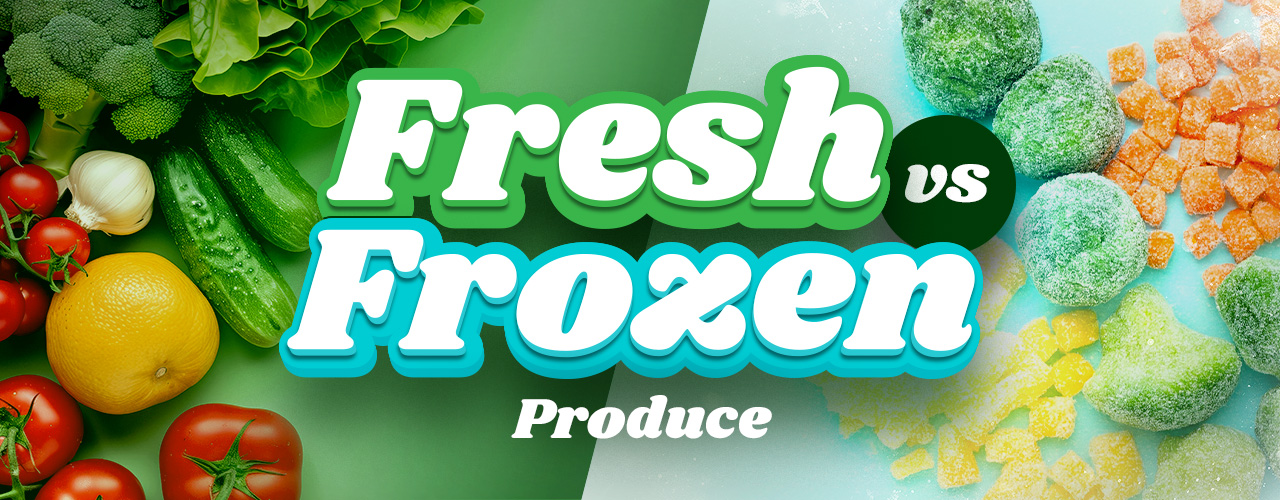Using high-quality produce is essential in any commercial kitchen, but does it matter if that produce is fresh or frozen? Both fresh and frozen options offer valuable benefits, making them suitable choices for your culinary applications. Fresh produce is often praised for its flavor and texture, while frozen produce offers convenience and extended shelf life. Whether you're preparing sides for entrees or crafting a vegan menu, both fresh and frozen produce can be incorporated into your menu to provide customers with delicious and nutritious meal options. We’ll compare the different ways produce is sold and how you can make the most of those ingredients in your kitchen.
Shop All Fruits and VegetablesWhat Is Fresh Produce?

Fresh produce refers to fruits and vegetables that have not been processed or preserved in any way. Whether purchased at a farmer’s market or ordered in bulk from a food distributor, chefs are often on the hunt for the freshest produce for their menus. Fresh produce is sought after for its vibrant flavors, textures, and nutritional content. When using fresh produce, you’ll want to consider factors such as seasonality, storage requirements, and shelf life.
Benefits of Fresh Produce
Choosing fresh produce for your restaurant menu offers some of the following benefits for your business:
- Enhanced Flavor and Texture: Fresh produce often boasts a bolder taste and texture, offering a crispness and juiciness that can be lost during the freezing or canning process.
- Vibrant colors: The bright hues of fresh fruits and vegetables can enhance the presentation of menu items, attracting customers with their colorful and appetizing appearance.
- Seasonal Variety: Fresh produce allows for the enjoyment of seasonal flavors that can be showcased on a menu. By utilizing seasonal produce, businesses can offer unique and limited-time dishes to drive sales during peak seasons.
- Customizable Preparation: Fresh produce provides chefs with the flexibility to prepare dishes to their liking, allowing them to cut produce and prepare it to the precise specifications of a recipe.
- Attract Health-Conscious Customers: Fresh produce is often associated with health and wellness, making it a popular choice among health-conscious consumers. By prominently featuring fresh produce in menu items, businesses can attract customers seeking nutritious and wholesome dining options.
Considerations for Fresh Produce
There are some considerations to keep in mind when stocking up on fresh produce:
- Shorter Shelf Life: Fresh produce has a limited shelf life and may require more frequent restocking, leading to potential waste if not used promptly. However, you can make the most of overripe produce by putting it to good use. Overripe fruits can be added to smoothies, desserts, or as toppings for yogurt or oatmeal. Vegetables can be roasted, blended into soups, or used for sauces, salsas, and spreads.
- Handling and Storage: Proper produce storage practices are crucial to maintain the freshness and quality of fresh produce, requiring careful attention to temperature, humidity levels, and ethylene emissions.
- Price Fluctuations: The cost of fresh produce can vary depending on factors such as seasonality, weather conditions, and transportation costs, impacting overall food costs for commercial establishments.
How to Use Fresh Produce
Fresh produce is excellent for dishes where taste and texture shine, especially in raw applications. Reach for fresh vegetables for salads, sandwiches, garnishes, and vegetable platters. Use some juicy fresh fruit for fruit salads, frozen yogurt, parfaits, and tarts. The vibrant colors and crisp textures of fresh produce can enhance the visual appeal of dishes and provide a burst of freshness that complements the overall flavor profile.
What Is Frozen Produce?

Frozen produce is fruits and vegetables that have been processed and frozen to preserve their freshness. When it comes to frozen produce, convenience and versatility are key advantages for commercial kitchens. Frozen produce is picked at peak ripeness and quickly frozen, locking in nutrients and flavor. With a longer shelf life and reduced waste, frozen produce offers cost savings and consistent quality year-round. Some of the most commonly frozen vegetables include broccoli, carrots, cauliflower, green beans, peas, and corn. For frozen fruit, you will often find options like berries, pineapple, mango, and even tropical fruits like acai and dragon fruit.
Benefits of Frozen Produce
Using frozen vegetables in your kitchen can benefit your business in many ways:
- Extended Shelf Life: Frozen produce has a shelf life of approximately 8-12 months, allowing for better inventory management and reduced food waste.
- Nutrient Retention: Frozen produce is often harvested and flash frozen at its peak ripeness, preserving essential nutrients such as vitamins and minerals.
- Convenience: Frozen produce is already washed, peeled, and chopped, making it a convenient option for busy commercial kitchens. This can save time and labor costs associated with prepping fresh produce.
- Cost-Effective: Frozen produce is typically more affordable than fresh produce, making it a budget-friendly option for commercial kitchens.
- Seasonal Availability: Frozen produce is available year-round, regardless of the season. This allows businesses to offer a consistent menu with a wide variety of fruits and vegetables, even when certain items are out of season.
Considerations for Frozen Produce
Factor in the following considerations when adding frozen produce to your inventory:
- Texture Changes: Freezing can alter the texture of certain fruits and vegetables, such as leafy greens, causing them to become softer than desired when thawed.
- Flavor Variations: Some frozen produce may experience flavor changes due to the freezing process, impacting the taste compared to fresh alternatives.
- Limited Culinary Uses: Certain recipes or dishes may require the fresh texture or flavor of produce, limiting the culinary applications of frozen alternatives.
How to Use Frozen Produce
Frozen produce can help you save time in the kitchen without sacrificing quality in your culinary creations. Create delicious muffins, smoothies, and frozen desserts with frozen fruit like berries, pineapples, mangos, and bananas. Stock up on frozen vegetables like peppers, onions, peas, and carrots, to make menu staples such as soups, stews, sauces, and stir-fries.
What Is Canned Produce?

Canned produce refers to fruits and vegetables that have been processed, sealed in cans, and preserved through heat treatment. Canned produce offers a convenient and cost-effective option for commercial kitchens looking to maintain a consistent supply of fruits and vegetables. Much like frozen fruits and vegetables, canned produce is picked at the height of the growing process and canned shortly after to preserve freshness. Canned produce offers an extensive shelf life, making it a practical choice for establishments with limited storage space or infrequent menu rotations.
Benefits of Canned Produce
Here are some of the top reasons why you may choose canned produce for your business:
- Extended Shelf Life: Canned produce has a shelf life that can be anywhere from 2-5 years. This makes it a convenient option for commercial kitchens with fluctuating demand.
- Convenient Storage: Canned produce can be stored at room temperature, reducing the need for refrigeration or freezer space.
- Cost-Effective: Canned produce is often more affordable than fresh produce, allowing businesses to save on costs without compromising quality.
- Consistent Quality: Canned produce maintains its quality and flavor over time, ensuring a consistent taste in dishes regardless of seasonality.
- Ready-to-Use: Canned produce is pre-cut, pre-cooked, and ready-to-use, saving time and labor in food preparation processes.
Considerations for Canned Produce
Keep the following in mind when purchasing canned produce:
- Added Preservatives: Canned produce often contains added preservatives like sodium to extend its shelf life. These preservatives can affect the taste of the produce.
- Texture Changes: The texture of certain fruits and vegetables may change during the canning and storage process. Some fruits and vegetables may become mushier when canned, which can impact their appeal and usability in certain dishes.
- Nutrient Loss: Canning produce involves high-heat processing, which can lead to some nutrient loss. Vitamins and minerals can be affected by the canning process, so it is important to be mindful of the nutritional content when opting for canned produce.
How to Use Canned Produce
Expand your menu with the help of canned produce. Use canned vegetables in soups, stews, and casseroles for quick and easy meal preparation. Canned fruits are ideal for creating pies, upside-down cakes, tarts, smoothies, and trifles, adding a burst of flavor to your dishes. Additionally, canned produce can be used as toppings for pizzas, sandwiches, and wraps, providing a convenient way to enhance menu options. Canned produce can be highly beneficial for mobile businesses that lack ample refrigeration space.
Fresh, Frozen, and Canned Produce FAQ
These are some of the most frequently asked questions when talking about fresh, frozen, and canned produce:
Frozen vs Canned Vegetables
When comparing frozen and canned vegetables, both options offer convenience and long shelf lives, making them ideal for commercial kitchens. Both are typically harvested at peak freshness. Frozen vegetables are quickly frozen to retain nutrients, flavor, and texture. They require freezer space for storage. Canned vegetables are preserved in cans, providing a convenient pantry staple with a longer shelf life. They often have a softer texture than frozen vegetables when used in recipes.
Are Frozen Vegetables Healthy?
Frozen vegetables are healthy and useful for a variety of recipes. Raw vegetables intended to be frozen are picked in peak season and then frozen. Through this process, vegetables don’t lose much nutritional value. Researchers have concluded that there are minimal nutritional differences between the fresh and frozen versions of a specific vegetable. Nutrients like vitamin C, vitamin A, potassium, folic acid, and fiber do not mind being frozen and therefore do not lose their nutritional value once being reheated.
Are Canned Vegetables Healthy?
Canned vegetables are a healthy option in a commercial kitchen. While the canning process may result in some nutrient loss, studies have shown that canned vegetables can still retain a significant amount of their vitamins and minerals. Additionally, canned vegetables are often more affordable and readily available compared to fresh produce, making them a practical choice for foodservice establishments looking to incorporate a variety of vegetables into their menu offerings.
Does Frozen Fruit Go Bad?
Frozen fruit does go bad, but at a much slower rate than fresh fruit. When stored properly in the freezer at 0 degrees Fahrenheit or below, frozen fruit can last for up to 12 months. It is important to check for any signs of freezer burn, such as ice crystals or discoloration, which can affect the quality of the fruit. Properly sealed packaging can help maintain the freshness of frozen fruit until you’re ready to use it for your recipes.
Fresh, frozen, and canned produce options each have their own unique advantages, making them all valuable for chefs in commercial kitchens. Chefs can incorporate all three types of produce into their menus to create diverse and delicious dishes.








